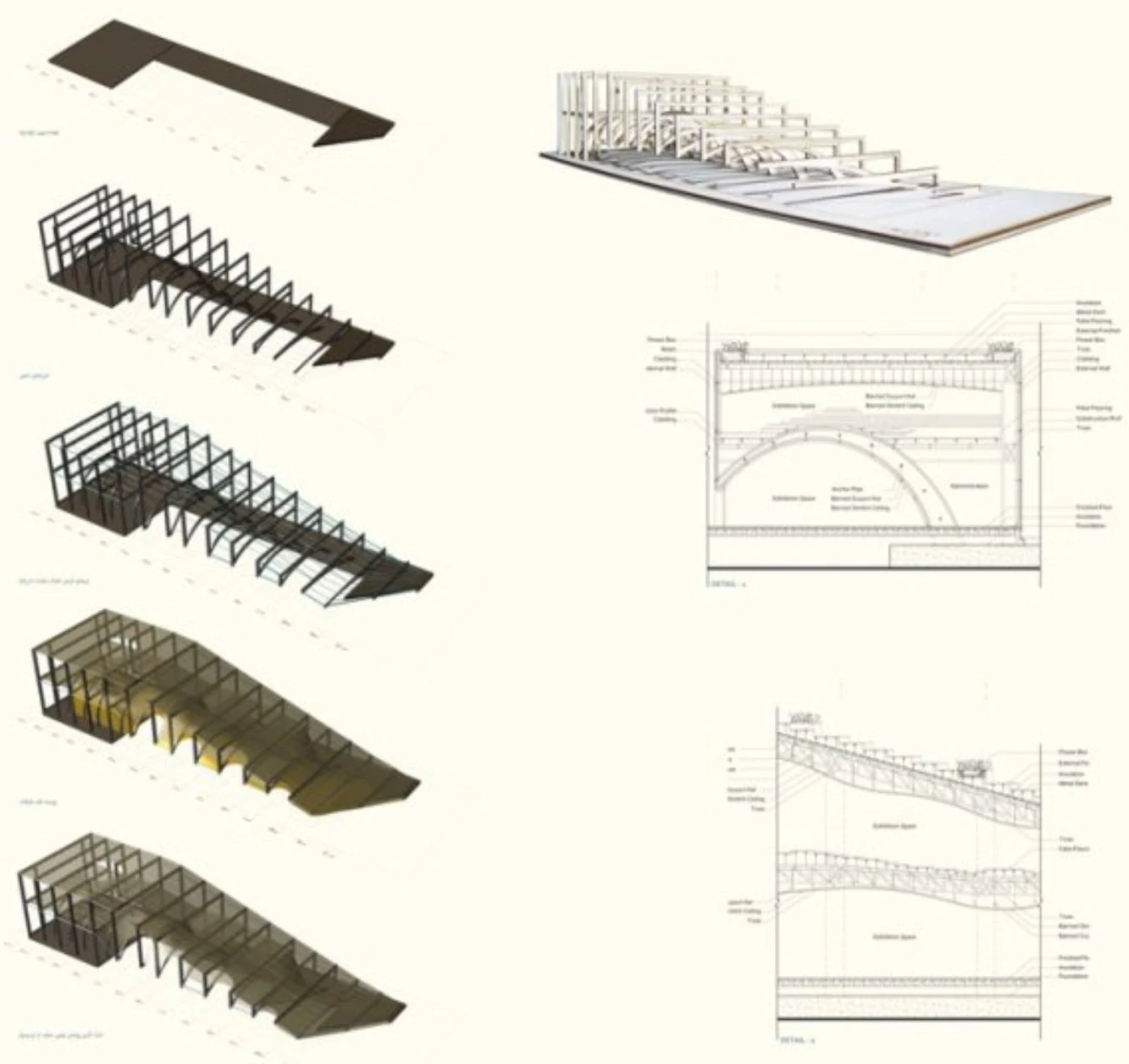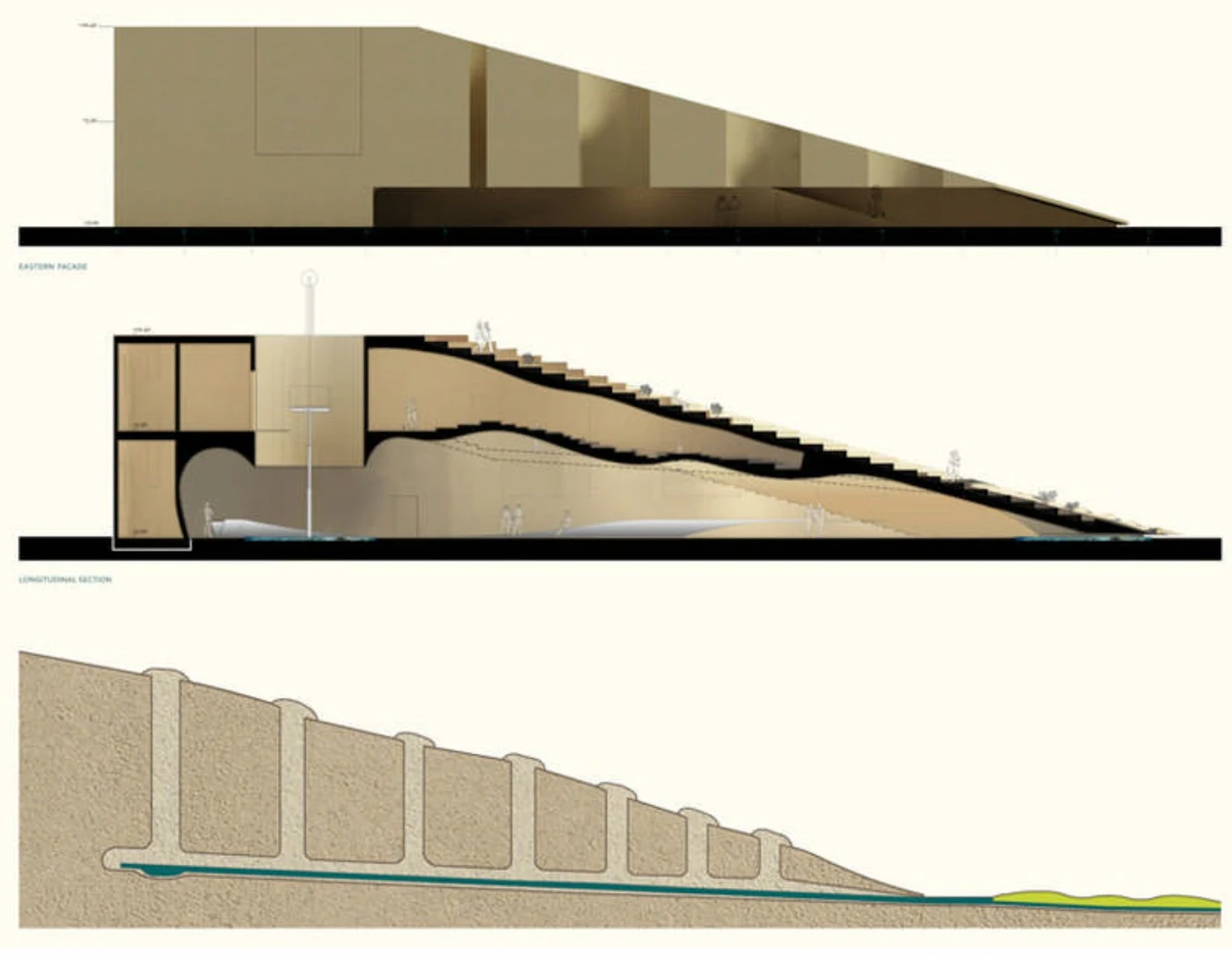
In proposed design of Iranian pavilion in the Expo of Milan, an effort has been paid to the above said scenarios in the cities of Iranian plateau to completely renovated with today’s image.

The main sequence include: highland, Qanat, Water, garden, farms and the city. the highlands have been presented by creating a slope where the Qanat’s wells are shown and under the final well (mother well) the spread of underground water is located.

The wells are connected in the lower part and at the end; water from the crack between the slope and ground finds an exterior presentation (Qanat’s manifestation). It is followed by gardens, farms and a water stream which irrigates them and at the end the city which in this case means the Expo Complex of Milan.

For better understanding of Qanat’s wells and the Qanat’s performance method, the project demonstrates a section of Qanat route and garden but not all of it, this way, the visitor at the passes through the garden will face the building elevation which is like a section of Qanat route and could easily enter the inner space.

This will cause by itself, that the visitors could first have the opportunity of seeing the garden,Qanat’s manifestation and a section of a Qanat instead of the direct entrance from Decumanus boulevard. by organizing the negative space like Qanat’s well and by digging, the interior space has taken its shape and has been dug to the extent of creating more space in both surface and altitude Supporting and management areas are located behind this space.

Visitors after seeing the mother well, will follow the water course and will understand the whole space as a unity. rom this space and the elevator provided inside the well, one can reach over the sloped surface and can see the view of Iranian garden and from there the Expo exhibition of Milan. Coming down from the sloped area gives the impression of moving from the altitude (slope) of mountain foot lands to the fields of gardens and finally the city.

From the top of sloped area, the visitors will be directed towards the Iranian garden where agricultural and gardening products and Iranian food will be presented. Over the sloped area the balloons filled with Helium gas (like the clouds in high altitude) are located and are connected by cables. This cloud will be moved over the project’s sky and will shade over the sloped surface of the building and will prevent the raining over the great part of it and in the meantime creates the possibility of demonstrating the projection of images in the evening.

The building facade color has been chosen as the natural color of Iranian soil where in the sectioned “Qanat” wells, in their interior sides, some spots of turquoise color represents a well-known Iranian stone could be seen. This part of the facade will allow a defused light to the building during the daytime and will permeate a defused light in the evening.



Location: Milan, Italy Architect: NJP (Naqsh, E, Jahan-Pars Consulting Engineers) Local consultant: Lad, Italy Project and Design Manager: Hamid Mirmiran Design Consultant: Iraj Etesam, Nasrine Faghih, Francesco Napolitano (LAD) Coordination Manager: Farideh Saebi Co-Designer and coordinator: Saman Sayar Project Team: Maryam Rahimi Danesh, Hiva Farajpoor Bakhtiari, Saeed Amirzadeh (LAD) Project Associates: Maryam Shirsalimian, Shima Aghaei Karim, Mana Ghabussi, Azadeh Piroozmand, Tina Fazeli, Mina Shamisa Conceptual Programming: Mohammad Salari far, Amin Masoodi Area Planning Studies: Nader Roozrokh, Tohideh Yadegari Structure Studies: Ehsan Sabaghi, Ali Etesam Mechanical and Electrical Studies: Behrooz Alamdar Milani, Hamidreza Lahijani 3D Renders: Majid Jahan-mehr, Nazli Milani Model: Hossein Ghaffari, Saeed Toodeh Fallah, Alireza Khosravi Graphic Design: Reza Soltani-Zadeh Photography: Hamidreza Framarzi, Azad Zargami Year: 2013 Competition: First Prize Winner